Paint that’s safe for you and the planet

In a country like Bangladesh, where urban air pollution is already a growing concern, what if the walls inside your home were contributing to the problem too? Unbeknownst to many, traditional paints can silently release harmful chemicals into indoor air, sometimes for years after application.
Eco-friendly paints are emerging as the new standard within the paint industry, driven not by aesthetics alone but by the urgent need for safer indoor environments. "Paint is still perceived primarily as decorative, when in fact it can contribute to air quality, surface protection, and long-term structural value," said Syed Salahuddin Abu Naser, Business Director of Dulux Paints Bangladesh.
Shades of care
As awareness grows around healthier living environments and sustainability, more Bangladeshi homeowners, architects, and developers are turning to eco-friendly paints, and the paint industry is responding with greener alternatives. Leading brands have embedded health benefits into its products.
For instance, Nippon's Spotless Plus, Q-Glo, Easywash interior paints boast antiviral and antibacterial properties. For exteriors, they offer WB Dirt-Shield, specially designed with superior dirt resistance to help maintain the cleanliness and hygiene of your home's outer surfaces. "We are committed to promoting well-being through low-VOC and lead-safe formulations, ensuring safer indoor air quality," added Rajesh Sircar, General Manager at Nippon Paint Bangladesh.
Berger Paints Bangladesh is taking this one step further. "We are reimagining what paint should stand for—as a product, a process, and a platform for responsible progress," explained Md Mohsin Habib Chowdhury, COO & Director of the company. Berger's flagship innovation, EcoCoat, is marketed as South Asia's first anti-pollution paint.
Using advanced Air Purifying Hybrid (APH) Technology, EcoCoat actively absorbs and neutralises pollutants like carbon dioxide, nitrogen oxides, and formaldehyde, which results in up to 90% improved indoor air quality, according to the company's research. The paint is entirely lead-free and formulated with green-certified biocides, offering safe choice for families conscious of the air they live in.
Similarly, companies like Aqua Paints, Asians Paints and Dulux are also increasingly advancing low-VOC content paints focusing on indoor wellness. This shift from traditional to eco-conscious solutions is a response to both consumer awareness and scientific evidence. Paints containing volatile organic compounds (VOCs), formaldehyde, and heavy-metals such as lead, mercury have long been associated with health risks, ranging from headaches and nausea to long-term respiratory and neurological issues. Eco-friendly paints offer a viable alternative, reducing exposure to these invisible but harmful chemicals.
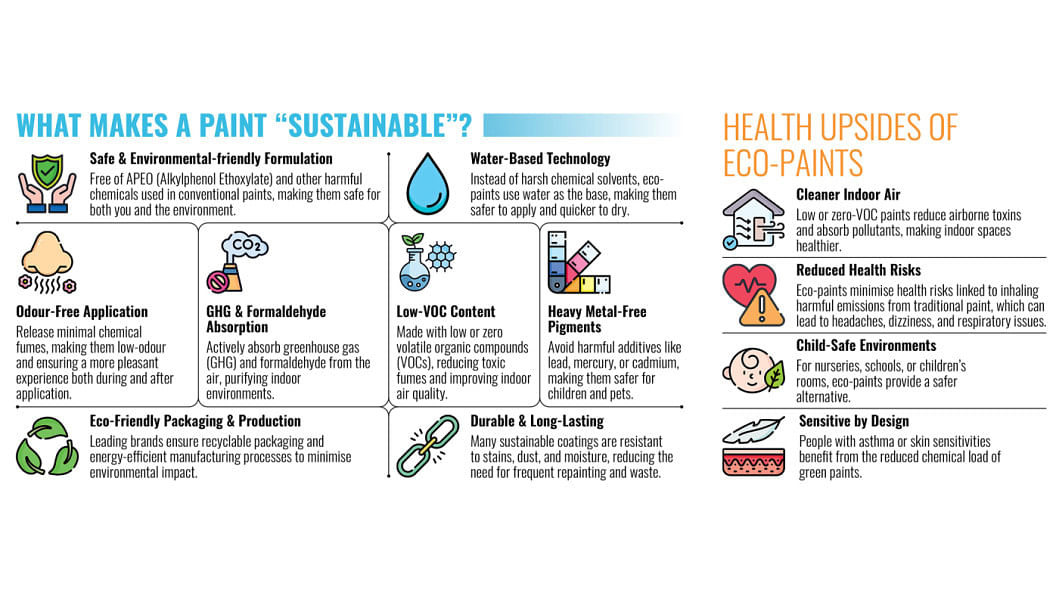
Good for your walls, great for the planet
Sustainable paints go far beyond being health-friendly, they are engineered for durability, climate resilience, and environmental protection. These next-generation coatings are ideal for Bangladesh's weather extremes, from scorching summers to relentless monsoons.
"We're advancing eco-conscious options like low-VOC paints, anti-saline coatings for coastal zones, and elastomeric roof compounds that reflect heat and resist monsoons," shared Shayaan Seraj, Director of Aqua Paints. Such innovations not only protect homes from environmental wear and tear but also help regulate indoor temperatures, reducing the need for air conditioning and promoting energy efficiency.
Nippon's WB Solareflect line echoes the same principles. Its Sunblock Technology offers significant heat resistance, helping to lower surface temperatures by up to 5°C. The paint is also twice as resistant to UV damage, dirt, fungus, algae, flaking, and efflorescence. With no added lead or mercury, it balances high performance with environmental safety.
Berger's EcoCoat adds another dimension to sustainability, actively capturing harmful greenhouse and toxic gases. This contributes directly to mitigating climate change. Berger is also phasing out non-green preservatives and transitioning from solvent-based paints to low-VOC, APEO-free, water-based alternatives. "Increasing the share of water-based solutions across our portfolio is a key priority as we align with global sustainability standards and evolving consumer expectations," said the company's director.
Durability also means fewer repaints and reduced environmental strain. Asian Paints Bangladesh's Ultra Nonstick exemplifies this principle, offering a premium dirt-repelling, anti-stain polymer technology that reduces the need for frequent cleaning and repainting. This indirectly supports a healthier indoor environment by minimising chemical use.
Echoing these values, Dulux Paints is expanding its range to include washable, humidity-resistant finishes and eco-conscious ingredients. "Our mission is to make homes in Bangladesh last longer, look better, and breathe safer," said Naser of Dulux Paints. "The Weather Shield Max line is purpose-built—resisting monsoon moisture, urban grime, and fading sunlight."
From heat-reflective coatings to gas-absorbing formulations, sustainable paints are proving to be more than just a green choice, they're a smarter investment for homeowners and the planet alike.
Still unsure? Feel the finish firsthand
Paint companies are also crafting immersive experiences that allow customers to visualise colours on their walls long before a brush ever touches the surface. "We envision using Oakley smart glasses and Oculus headsets for immersive pre-paint simulations," mentioned Seraj from Aqua Paints. This push for technology-integrated service aims to help customers preview the final outcome more realistically.
Similarly, Nippon Paint is using digital tools to enhance personalisation. "The i-Colour App lets customers visualise colours digitally on their own walls, enhancing personalisation," explained Sircar of Nippon Paint Bangladesh.
Dulux has also enhanced the customer journey with bilingual shade guides and doorstep sampling, making the process intuitive and inclusive. Additionally, the Dulux Visualiser App—an AR (augmented reality) based colour preview tool—is being evaluated for localised rollout in Bangladeshi homes.
As more people embrace green living, eco-friendly paint is no longer a niche market. It's becoming the new standard. And in a country like Bangladesh—where every square foot counts, and every breath matters—it's a welcome change worth spreading.

 For all latest news, follow The Daily Star's Google News channel.
For all latest news, follow The Daily Star's Google News channel. 

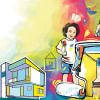
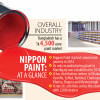
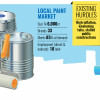
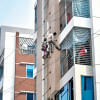


Comments